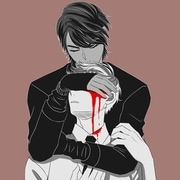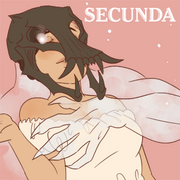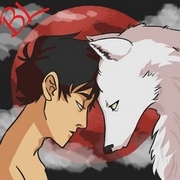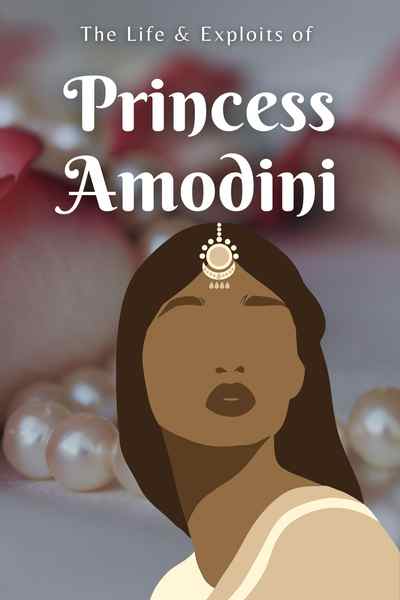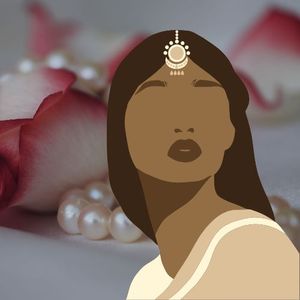Common Attire in Princess Amodini's world
This book is a work of fiction based in a parallel universe of ancient India. The clothing, described here, is derived from the traditional dress of ancient India, which is one of the main pieces of evidence marking the existence of gender equality during that period. Most historians agree that both men and women, even children, wore the same three pieces of clothing that constituted the complete dress. These three pieces are referred to liberally throughout this book and are essential to the plot.
The lower body garment, called Antariya, consists of a cotton cloth, mostly white, five yards long, tied below the navel, and covering the entire lower body up to the ankles. The front end of the antariya hangs in long pleats from the waist till below the knees while the other end is passed through the legs and tucked at the back. The men in ancient times wore loosely-fitted antariyas while the women sometimes also wore tightly-fitted or knee-length ones. Over the centuries, the antariya has evolved into its current form called dhoti, specifically worn by Indian men.
The garment covering the upper body, called Uttariya, consists of a single loose piece of cloth, cotton or silk, maximum two yards long, similar to a shawl. It can be draped in a number of ways. The evolved version is called the dupatta and is a vital part of the female dress in India. For the sake of convenience, in this book, the characters, both male and female, drape it over their person in only one single way. One end goes over the left shoulder and covers the entire chest and torso, up to the navel. The other longer end of the same cloth is pulled from behind the waist, passed under the right arm, wound three times over the front of the abdomen, like a belt, and tied securely at the back. The antariya and uttariya together constitute the main parts of the traditional costume and shall be referred to as a common attire or garments throughout this book.
The third piece, called Kanchuka, is a light-weight, full or half sleeved, jacket. Soldiers wore a kanchuka made of leather, under their armour, when marching into battle. In daily life, however, a cotton alternative is mainly worn by little girls. In this book, the kanchuka is described as a light-weight jacket for ease of reading.
A fourth piece of cloth, only for women, is the Stanpatta. It is literally an ancient version of the bra. It is a single strip of cotton cloth, mostly white, wound a number of times over the breasts and shielded under the uttariya. The modern version is the choli or Indian-style bodice, available in various colours, shapes and sizes, worn with a sari or lehenga or palazzos. In this book, the stanpatta is described as a bodice only.
Apart from the above, the people also wore a cummerbund, known as kayabandh over their torso. It's usually a tightly wrapped, broad belt of thick cotton or leather, for added support to the antariya. Although its unisex, this book uses the cummerbund as part of the male dress only in an effort to reduce complexity.
The headdress in India is exceptionally complicated even to this day. It differs by gender, age, region, caste, sub-caste, socio-economic factors, occasion and season. This book has completely omitted the headdress for both genders since the plot works well without it.
The Sari is still the most traditional women’s garment in India, consisting of a single cloth of seven yards, made of all kinds of fabric, and elaborately draped around the body in a large number of ways, depending upon the region. A cotton skirt, tied with a drawstring at the waist is worn under the modern-day sari, along with a half-sleeve cotton sari-blouse. The sari, worn by some of the characters in this book, uses either cotton or silk fabric, and is paired with the same kind of skirt and stanpatta, instead of the sari-blouse.
Indian jewelry is also pretty elaborate. Both men and women can wear gold or bronze danglers and necklaces, armbands, waistbands, wristbands or bangles, toe-rings and anklets depending on their financial status. However, the danglers, anklets and wrist bangles are the most basic ornaments worn by all. The Royals of Satayu also wear pearls embedded in their gold jewelry as a mark of their ancestry. Teachers and students at the university wear mostly beaded strings instead of gold or bronze.
Hair is the last piece of the ensemble. Young women tie their hair into plaits, little girls into pigtails and older women wear it as a chignon on top of the head. Men keep the hair loose over their shoulders or tie it into a top-knot depending on the length. Sometimes both genders can be seen with dreadlocks.
This preface can be used as a reference for terms in all books in this series. It is not to be used as a foundation for understanding the traditional dress worn in ancient or modern India. More reliable sources can be found both online and offline with considerable research.

